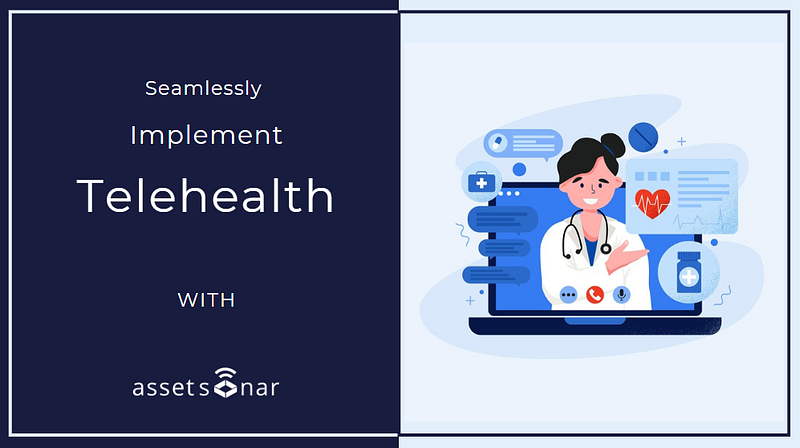As traditional healthcare systems grapple with the global pandemic, telehealth technology has come to the forefront as an effective way to safely reach more patients.
It is enabling healthcare providers and caregivers to remotely respond to the needs of all kinds of patients who want to touch base with physicians on the symptoms and status of their health.
What is telehealth?
Telehealth is the use of electronic data and telecommunications technology to facilitate remote patient monitoring and medical treatment, caregiver training, patient and professional health education, and public health administration.
It primarily leverages technologies such as machine-to-machine communication of medical devices, videoconferencing, store-and-forward imaging, media streaming, and internet and wireless communications.
Currently, telehealth is fulfilling three primary roles to strengthen health systems.
- Remote, virtual communication with physicians, and tele-triage are helping to curb the spread of the COVID-19 among the mass population and the medical staff on the frontlines.
- Remote care and supervision, and routine video visits are protecting patients with chronic diseases and compromised health to get regular treatment without COVID-19 exposure.
- Infected and quarantined healthcare providers can continue seeing and examining patients via remote feeds, without becoming unavailable to the healthcare system just when it needs them the most.
How are hospitals adapting to telehealth during the pandemic?
84% of patients surveyed in the US are more likely to select a healthcare provider that offers telemedicine over one that doesn’t.
As the CDC calls healthcare facilities to adopt telemedicine technology, many hospitals are scaling up. They are increasingly investing in integrated medical devices and telehealth applications to facilitate remote monitoring of patients in quarantine wards and at-home.
Most hospitals have partnered with telehealth providers that offer both telemedicine hardware and software solutions.
Hardware used in telehealth
Telehealth hardware typically consists of the following:
- Telemedicine or homecare kit
- Telemedicine cart
Telemedicine, or homecare kits, can be shipped directly to the quarantined patients for use at home.
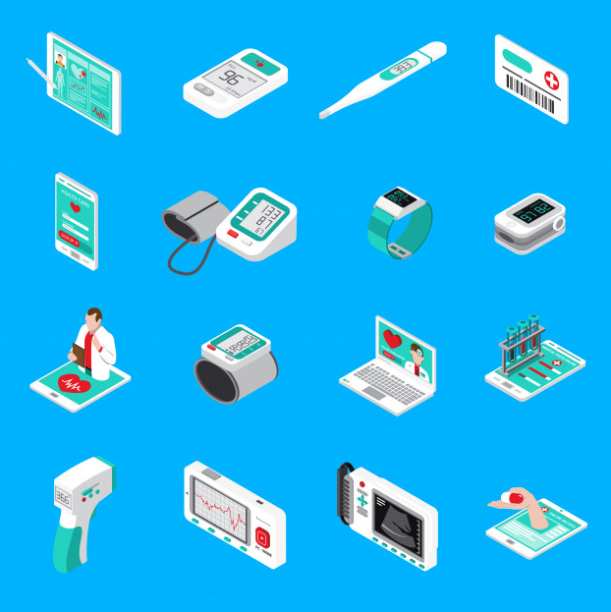
They typically include IT equipment and medical peripherals such as:
- A windows laptop/tablet
- Speakerphone
- HD Webcam
- Digital stethoscope
- Digital thermometer
- Pulse oximeter
- 12-lead ECG/EKG
- Handheld ultrasound system
- Otoscope
- Dermatoscope
- Wireless blood pressure monitor
- Glucometer
- Spirometer
These kits are customizable and can be assorted based on a patient’s needs as illustrated.
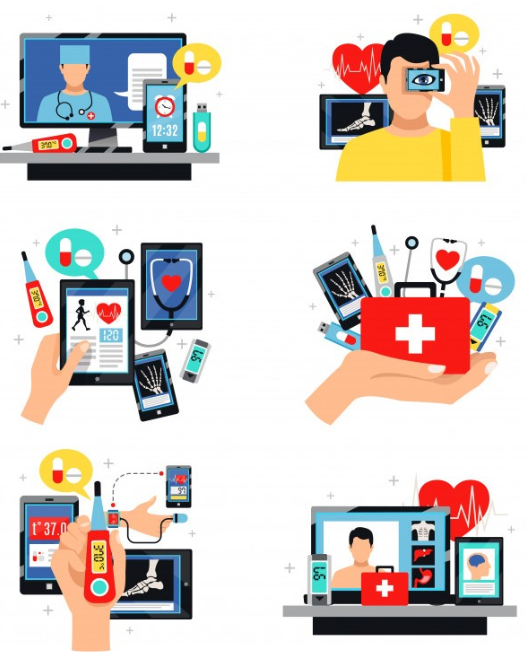
In the face of COVID-19, telemedicine kits may also include testing equipment to facilitate home-based testing.
Telemedicine carts, on the contrary, are deployed by healthcare institutes for physicians on their premises. They consist of:
- A simple lightweight cart
- A small form factor PC/medical grade monitor
- A keyboard and remote control
- A remote-controlled PTZ camera
- A Codec (to encrypt patient information)
- Echo cancellation speaker and microphone
- An all-in-one scope for real-time device streaming
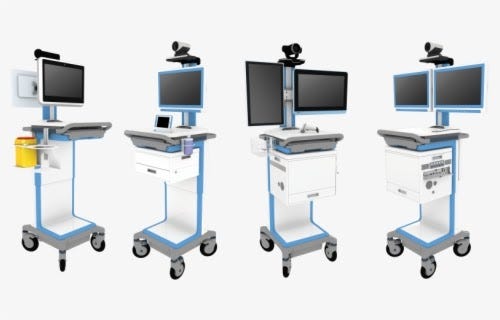
Carts are portable and can also be customized for clinical or educational purposes for instance training, meetings, and interviews, etc.
Despite its benefits, telemedicine has its fair share of challenges too.
Challenges faced by hospitals in implementing telehealth
Concerns regarding internet connectivity and bandwidth for successful telehealth delivery generally reside with the government.
However, hospitals face various other challenges while implementing and managing telehealth IT infrastructure. These include:
- Remote oversight of IT devices and medical peripherals
- High overhead and maintenance costs of telehealth infrastructure
- Ensuring 24/7 clinical continuity and care coordination
- Provision of competent, uninterrupted technical support
- Security of patients’ personal, medical and health insurance data
Since telehealth is largely dependent on hardware and software applications for clinical provision, many of these issues can be tackled effectively by streamlining the management of a hospital’s IT workflows.
AssetSonar offers powerful IT asset management that keeps a centralized database of all your medical hardware and software. It enables remote management of your telehealth infrastructure, allowing you more agility and flexibility. Here are some key features of AssetSonar that hospitals can use to seamlessly implement telehealth technology.
1. Remote tracking of telehealth hardware
Deploying a telehealth system means a widespread distribution of your assets. You have to check out telemedicine carts to each of the licensed physicians and specialists. Similarly, hundreds of telemedicine kits lie at patients’ residences.
Most of these devices are high-performance and costly. They also store valuable patient data. Therefore, hospitals cannot afford to lose or misplace them. In an instance of a lost laptop, an employee of Philadelphia’s Department of Behavioral Health and Intellectual Disability Services was reported to put data of 1,500 patients at risk. This makes remote oversight of your medical hardware crucial.
AssetSonar makes tracking of hardware easy. It keeps a comprehensive database of all your IT assets and medical peripherals and their availability status. This way, you can quickly reserve and check out equipment and make sure your staff and patients have quick access to telehealth devices.
The system also offers a pre-configured Agent that you can install in your IT assets before checking them out to their respective locations. The Agent detects IT assets, even when they’re off the hospital premises.
Furthermore, you can assign custody to each of the items, while checking them out. This ensures accountability — individuals will use the devices with care and can be held liable if a device goes missing, is stolen, misused, or broken.
AssetSonar also helps you optimize procurement by identifying underutilized hardware. Stay lean and lower storage and overhead costs with our inventory management module.
A detailed record of the movement, location and custody of your telehealth hardware within AssetSonar ensures that you’re always compliant with the HIPAA Security Rule.
2. License management of telehealth applications
As mentioned earlier, hospitals also purchase different software applications to facilitate telehealth operations. Some prefer an all-in-one customized telehealth application.
Others buy a set of tools for the following:
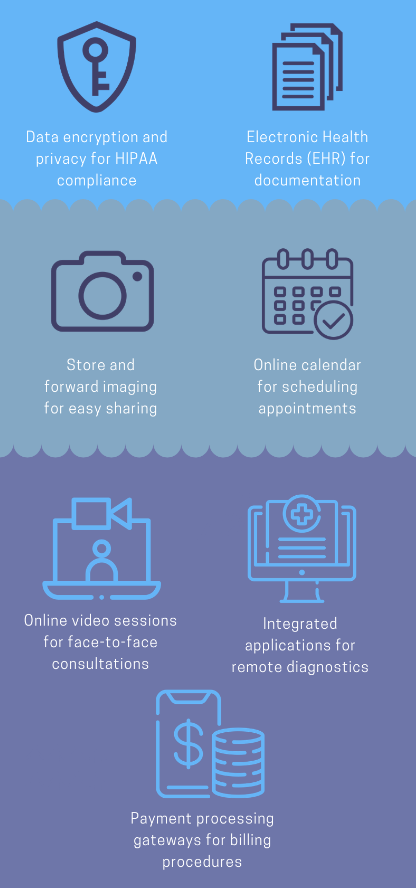
Keeping a comprehensive overview of such applications and their license payments is grueling, especially when IT assets are dispersed. Missing a license fee payment may even interrupt your use of the relevant software, thereby disrupting clinical provision.
AssetSonar saves you the trouble with its software license management module. It alerts you when critical software applications are about to expire so you can prompt license or warranty renewals, and make timely fee payments. This ensures continual use of key tools and precludes any business disruptions.
You can run detailed license reports on all your detected IT devices to locate instances of unlicensed software. This also helps steer clear of vendor penalties and true-up costs so you’re always compliant.
3. IT service management for accurate and continuous care
It is imperative for medical devices to stay functional for accurate and continuous treatment. Imagine a malfunctioning glucometer that reports a lower blood glucose concentration of a patient when in fact it is high.
Based on the inaccurate information relayed by the glucometer, a physician may ask the patient to take supplements high in carbohydrates. This can further aggravate the patient’s glucose level and may even lead to a diabetic coma.
Also consider this hypothetical situation: A person with hypertension is experiencing symptoms that signal a cardiac attack. The patient’s caretaker has to share the EKG’s results with the doctor but the laptop storing this data breaks down in the process. This discontinuation may threaten the patient’s life.
Alternatively, a patient’s EKG may be defective and can report abnormally high heart rate. The hospital may dispatch an ambulance and health resources but later, they find out that the patient was simply hooked up to a defective asset. The hospital must face unnecessary costs now.
Malfunctioning devices can pose a serious health liability to patients. Since most doctors and patients rely on these devices for better diagnoses and treatment, they must be kept in optimum working condition at all times.
Shawn Valenta, a Telehealth Administrator at the Medical University of South Carolina says IT service management is crucial for telehealth:
“…since telehealth is really a clinical service applied over an IT service, we saw an opportunity to leverage ITIL best practices and key concepts…We adopted the framework of ITIL and adapted it to fit our own needs.”
AssetSonar enables compliance with ITIL best practices by integrating with many leading service desks like Zendesk and Jira. It helps you resolve hardware breakdowns instantly, should they occur.
Concerned doctors and patients can create a ticket in Zendesk or issue in Jira when a medical device glitches or stops working. This alerts the IT team in a hospital so they can fix the issue.
Your IT team can also schedule regular health checks and connect with physicians and patients to see if the devices are working at their optimum. AssetSonar allows you to schedule recurring services for dedicated preventive maintenance.
Our integration with service desks supports ITSM workflows internally so you don’t have to hire third-party vendors for 24/7 technical support either.
4. Security protocols for HIPAA compliance

The Health Insurance Portability and Accountability Act (HIPAA) was passed in the US in 1996. It mandates protection of a patient’s right to privacy in both a face-to-face visit and a virtual telehealth consultation. This legally binds telehealth providers to the law as well.
For this reason, hospitals are required to install a data encryption software in IT assets storing patient data. However, in some cases, the software may be missing before you check out IT assets to concerned people. This may put the patient data at a huge risk of a security breach.
AssetSonar helps hospitals meet HIPAA compliance with its security protocols. Firstly, the entire AssetSonar database is hosted on the Amazon Web Services (AWS) infrastructure. AWS is designed to meet several security standards including ISO 27001, SOC 1, 2 and 3, FISMA, DIACAP, FedRAMP, and PCI DSS Level 1.
Furthermore, our IT asset management solution also has data fields for Firewall and Disk Encryption status. These indicate whether firewalls and disk encryption are activated in IT assets discovered by the AssetSonar Agent.
Activated firewall means your IT devices are protected from cyberattacks. Similarly, an active disk encryption status shows that all patient data and hospital records are stored in an encrypted form in the IT devices used by your physicians and patients.
Our system also displays whether certain antivirus programs installed in your IT assets have been updated. This shields from viruses like ransomware that take data and threaten to leak it.
You can also define customized user access rights and permissions to physicians and patients added in AssetSonar so they only get access to relevant data.
The features offered by AssetSonar make patient privacy a top priority and greatly enhance the security of dispersed medical devices.
Pro tip: Automate user provisioning for faster patient care
Another limitation hospitals face while deploying telehealth is to add licensed doctors, specialists, and patients in their constantly evolving Active Directories. They must also be provisioned access to certain telehealth applications. Manually doing so can take up valuable hours that can instead be used for patient care.
AssetSonar supports the SCIM protocol so you can automate user provisioning and give access rights to relevant users for applications including AssetSonar, service desks, and consultation tools, etc. This accelerates administrative processes so you can focus on delivering faster patient care.
Telehealth and AssetSonar: A virtually perfect medical solution
Public health crises pose unique challenges to effective healthcare delivery. However, if hospitals make strategic administrative decisions, they can seamlessly transition to a telehealth system.
In this instance, AssetSonar can prove to be a virtually perfect solution. It helps optimize spend management so you know which hardware to invest in and when. It gives the ability to remotely manage all your devices and have a holistic overview of the software licensing framework.
You can ensure 24/7 technical support with an internal ITSM infrastructure. Moreover, lower the possibility of liability claims by proactively maintaining your assets, protecting patient data, and complying with national health standards.
AssetSonar reduces administrative burdens tied to compliance and cost management so you can focus on quality health delivery and keeping your patients safe.
Read more: Recession Planning: A CIO’s Guide To Reducing IT Costs with AssetSonar
About AssetSonar
AssetSonar is the leading telehealth hardware asset management software. It offers powerful and intuitive remote management of your telemedicine hardware and software tools so you can deliver quality healthcare to patients.


